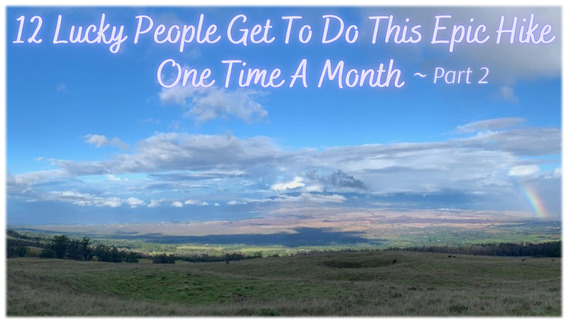
Waikamoi Preserve is one of Maui’s truly hidden treasures, a sub-alpine region that has an ecological makeup unlike any other place in the world.
Avid hikers love to explore unique plants and landscapes wherever they venture, so today, we are going to learn more about the myriad of unusual plants you will see in the Waikamoi Preserve. AND THEN, we will give you the information we promised (The secret to how you can take this hike, too!). One day soon, you too can breathe in the natural beauty of this delightful preserve.
Let’s follow a recent hike we had with friends!
As we leave the parking lot, we are not yet in the preserve. Going through the locked gate, we find ourselves on a rough, rocky, and root-filled road. We will walk about three-quarters of a mile before we get to the sign announcing the Waikamoi Preserve. The entrance is by permit only (your first clue that something special awaits).
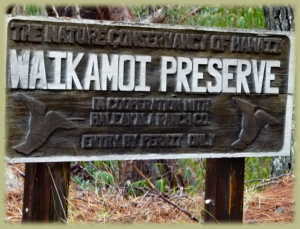
The first thing our guide shows us is two pests, both of which attack the Eucalyptus, and, Eucalyptus is NOT native. Neither are the pests. (Remember, we are NOT in the Preserve yet!).
 We come upon a beautiful tree, the Mexican Weeping Pine, a non-native.
We come upon a beautiful tree, the Mexican Weeping Pine, a non-native.
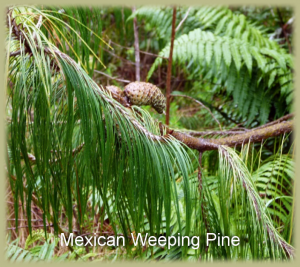
Our first endemic species is Ākala or Hawaiian Rasberry. It’s found between the 1,900 to 10,000-foot elevations. The Ākala is not very common except on Haleakalā*, especially in the Koʻolau* gap area. Its fruit is large and red and edible though sour and bitter. The birds LOVE these berries.
(In our commitment to honor tradition and authenticity, you can find a glossary of our Hawaiian words at the bottom of this blog.)

As we continue on the trail, it becomes quite narrow, and we walk single file, embraced by thick branches and tree limbs, ferns sprinkled at our feet.

Next, we come across beautiful Acacia Koa saplings, endemic to all the Hawaiian Islands. Their characteristic long, curved, and pointy leaves are their mature leaves (or phyllodes). The young leaves are the ones that look like fern fronds.

A short stroll away, we can see the Pukiawe, which has 10 other Hawaiian names. It is the only native Hawaiian plant that has been scientifically named for King Kamehameha the First, also known as Kamehmeha the Great*. Can you see the version of his name in the Latin botanical name of Leptecophylla Tameiameiae?
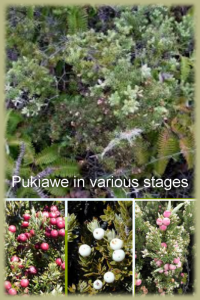
Pukiawe is indigenous and has been used since ancient times for a variety of uses. It can be found on all Hawaiian Islands except Niʻihau* and Kahoʻolawe*. It grows from sea level to the mountain’s subalpine forests. Its habitat can be windward* coastal territory, open spaces in low forests, wet forests, and even bogs and shrublands.
5 Uses of Pukiawe from Ancient Times
- Early Hawaiians would take the leaves of Pukiawe, mash it with salt, add water, and inhale the mixture to treat holopani upe nui*
- Fruits and the white liko* were incorporated into lei*
- The wood was carved into kua kuku*
- Criminals were cremated with the wood
- Our state bird, the Nene, consumes pukiawe in its free-range diet

Finally, one of the most extraordinary uses of Pukiawe involved the protocol of a ceremony in which the Aliʻi* would bathe in the fumes of burning dried burning Pukiawe leaves and branches while specific oli* were chanted.
Pukiawe exhibits a wide variety of shapes and characteristics due to its diverse territory.
In this case, it exhibits as a shallow, sprawling shrub or as a columnar, graceful tree. The bold bark is brown to black and on the twigs a bit scaly. The narrow, firm leaves are petite and prickly.
The diminutive white flowers resemble five-point stars. Round burgundy, red, pink, or white berries contain a hard pit like a peach. Each berry holds five to eight pale-brown, dainty seeds, which the birds spread to propagate this plant naturally.
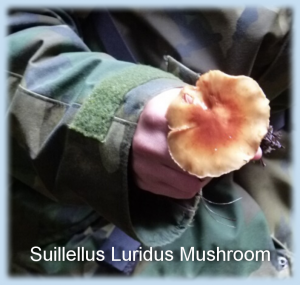
Nearby, we come upon this Suillellus Luridus mushroom, which must be present for conifers, such as pine trees, to grow. This mushroom indicates the spreading of the invasive pine trees, which takes away the crucial sunlight needed for the native species.
As we continue, we come to the boardwalk, which was constructed in memory of Rose Gardner, who gave generously to keep this area safe. This keeps the forest’s gems from being trampled by visitors.
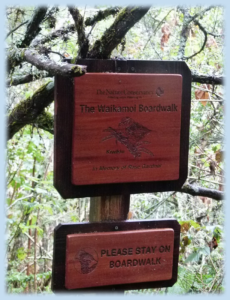
The boardwalk is narrow, like a diving board, and is covered with wire mesh for better grip. The total descent for the entire hike is about 35 stories or 700 feet.
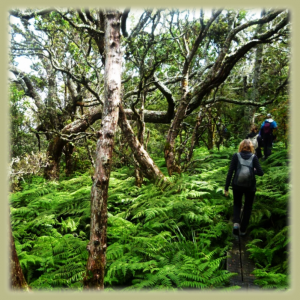
When you take the first step onto the boardwalk, prepare yourself for a radical change in the feeling of the forest. Here is a place like no other – it is an ancient endemic forest. Breathe in the special fragrances. Koa* and ʻŌhiʻa* abound, ferns cover the ground, and the songs of endemic and native bird species fill the air in an ancient chorus that will whisk you back to the feeling of pre-contact*.
It’s glorious as you step down into this forest time machine.
One of our rarest finds came next: here is the very rare and endangered Hāhā, also called Hawaiian Lobelia.

Hāhā is a species of Hawaiian Lobelia that is endemic to Maui.
It is thought that fewer than 50 individuals remain in the wild. Threats to the species include pigs, weeds, and more. The Plant Extinction Prevention Program has successfully out-planted individuals of these in the Preserve.
Here is one of the most widespread endemic species in Hawaiʻi, the Kanawao, blooming for us. It is perennial and evergreen. It is part of the hydrangea family.

Soon we reached a deck with benches

Here we will have our lunches and revel in the symphony of bird songs.
In case you missed this last week:
Listen to the Chorus of Native Songbirds of Waikamoi with us
As we continue, an ʻŌhiʻa* tree with Lehua* blossoms appears among the huge number of ʻŌhiʻa present. This species is said to blossom year-round, and we saw this one blossoming in October.

ʻŌhiʻa Lehua is the most common and varied of all native trees. The sheer number and variations of ʻŌhiʻa shrubs and tree forms, leaf colors, shapes, and floral colors boggle the imagination!

ʻŌhiʻa are essential trees for native landscapes.
It is the first thing to grow in lava. It feeds the birds and the bees on nectar, pollen, and their tiny seeds. They are not difficult to grow in urban landscapes, provided they have sun and excellent drainage. On Maui, we plant them to bring birds and bees to our yards.
The hard, strong wood is prized today for flooring, furniture, decorative poles, carvings, and ʻukulele keys.
Equally important, beautiful lei* made with flowers, flower buds, and liko* is still a favorite lei today as they were in times of old. The lehua blossoms come in gorgeous shades of red, yellow, and orange.
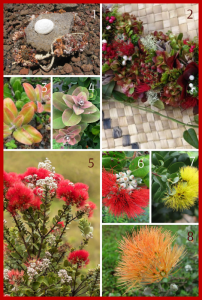
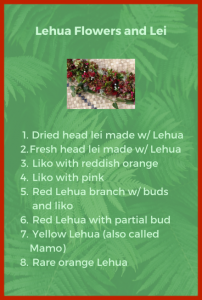
Leaves are still used as medicinal tea in folk remedies. Because of the abundance of nectar, the plants are classified as honey plants. The result is that Lehua meli* has a rare and pleasing flavor and creamy texture.
Now, what we promised to tell you: How YOU, TOO can hike in Waikamoi Preserve.
- The entire walk takes between 4 to 6 hours
- It is 3.5 miles in and out
- The elevation drop in the preserve is 700 feet down to the deck in the preserve. Also, the air is thinner here
- This hike takes place on the second Saturday of the month
- Reservations are required
- Only 12 people go in at a time so there is usually a 2 to 3-month lead time required for a reservation
Are you asking, “How can I go on this hike? If so, you will have to plan ahead. Believe us, it will be worth it!
If you want to sign up for this unforgettable forest experience, call 808-856-7666 or contact www.nature.org/Hawaiʻi to make a reservation for this hike in the Waikamoi Preserve – a native forest filled with exquisite songbirds and rare plants that most people never get to see or hear.
Writing and graphic creation by Sugandha Ferro Black (with help and some photos from Paul Janes-Brown)
GLOSSARY* of Hawaiian Words
Aliʻi – Aliʻi in the Hawaiian language refers to the hereditary line of rulers of the Hawaiian Islands.
Haleakalā – House of the Sun. A massive volcanic mountain on Maui that reaches 10,000 feet and forms 75% of Maui
Holopani upe nui – literally, a pain that nearly shuts off the breath, or congestion
Kahoʻolawe – 75 square mile island in Maui county off the western shore that is uninhabited and was used as a bombing target from 1941 until 1993 by the US Navy. It is now being restored with native plants.
Kamehameha the Great – Kamehameha I, the founder and first ruler of the Kingdom of Hawai’i
Koa – the largest of native trees
Koʻolau – refers to the windward sides of the islands, also a name of a particular type of tradewind and the name of a mountain range on ‘Oahu
Kua kuku – the wooden anvil used to pound tapa (kapa) the paper cloth made from the bark of the mulberry tree
Lehua – Flower of the ʻŌhiʻa tree
Lei – garland or necklace of flowers, shells, feathers, etc, given as a symbol of affection
Liko – refers to the new leaf bud
Meli – honey
Niʻihau – Niʻihau is the westernmost, seventh largest inhabited island in Hawaiʻi, privately owned and known for their gemlike lei pūpū (shell lei) and speaking Hawaiian as a primary language.
ʻŌhiʻa – the tree of the lehua flower, often referred to as the ʻŌhiʻa Lehua
Oli – a Hawaiian chant that is not danced to
Pre-contact – the period before contact of an indigenous people with an outside culture
Windward – it is indicative of the direction in which the wind blows toward the islands. In Maui, the north and east shores are the “windward side.”
*Please keep in mind that all Hawaiian Words have many meanings. The meanings we share here are the specific translations for the words as they pertain to this particular blog’s subject matter.
Photos courtesy of free or other paid for sources unless otherwise noted.
